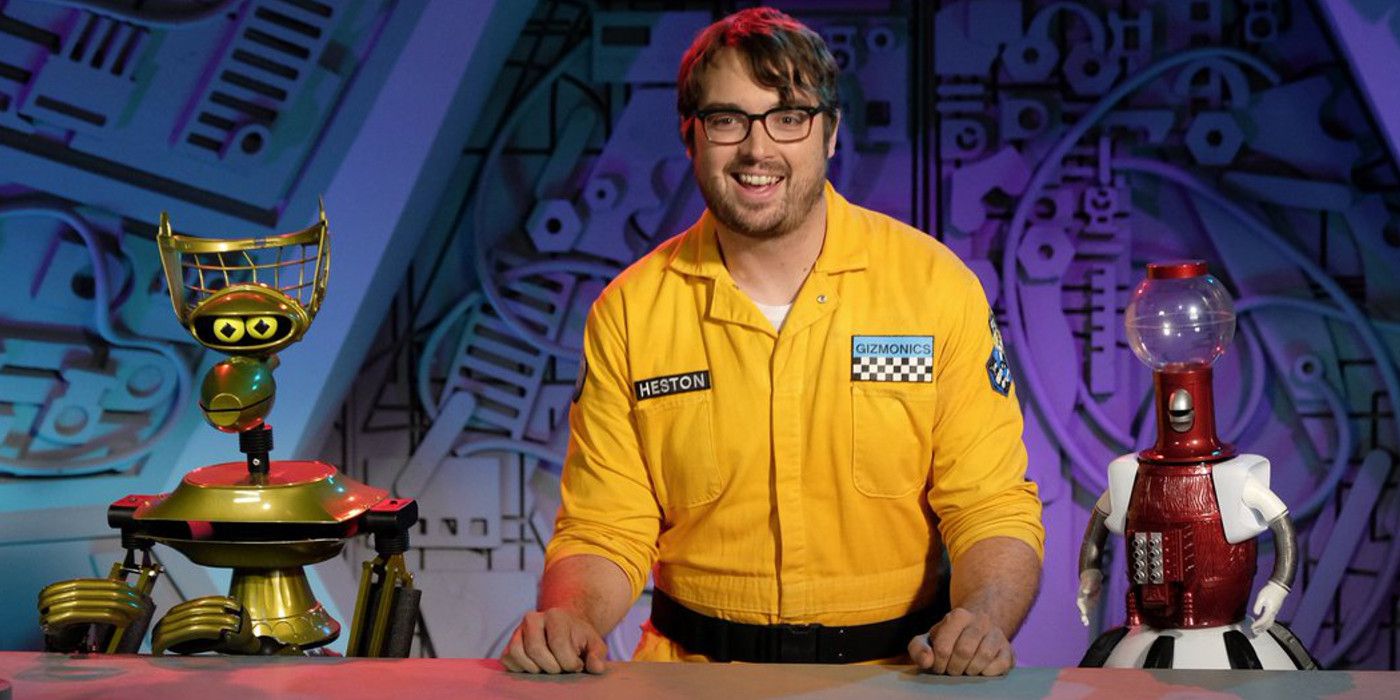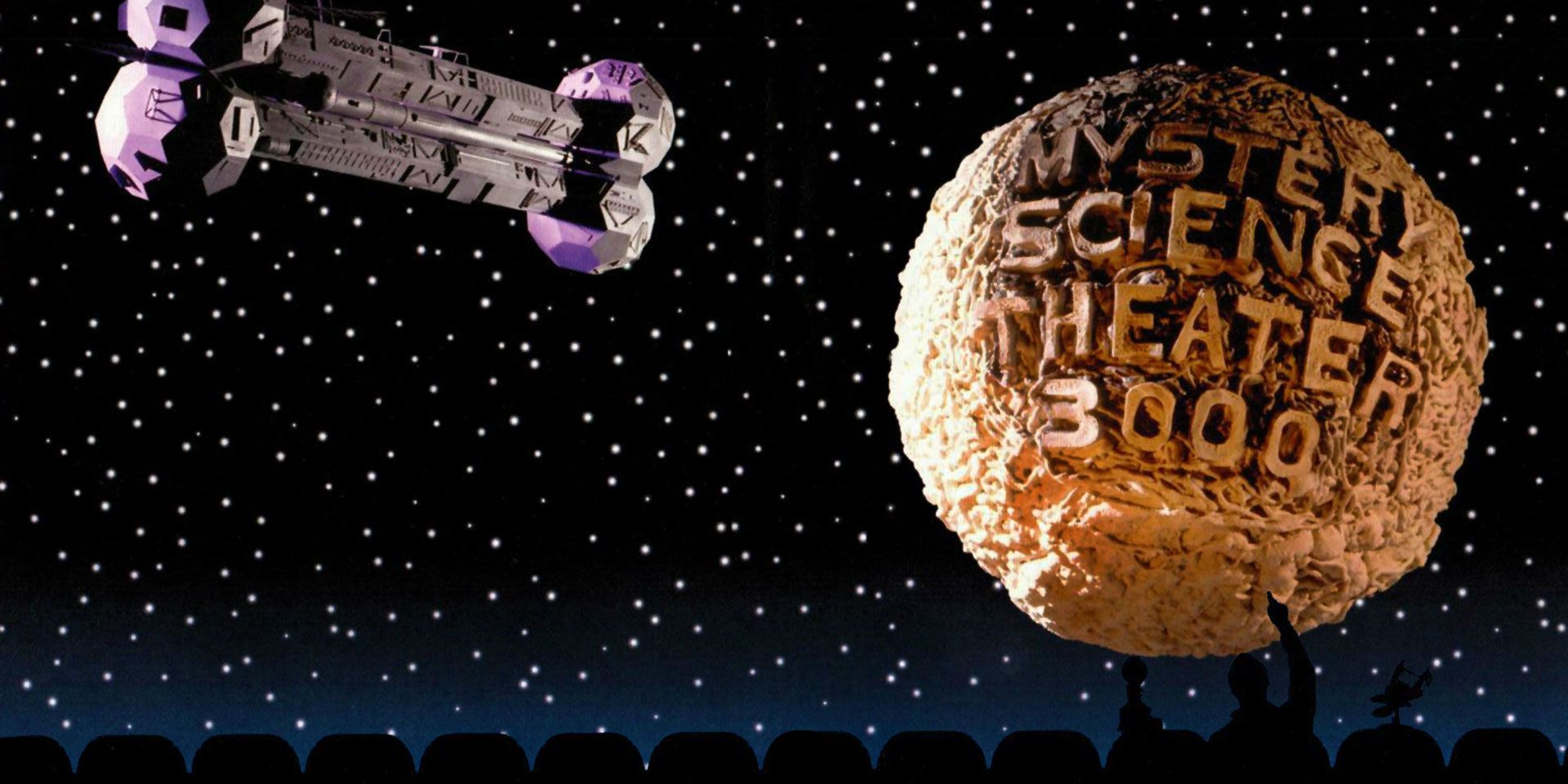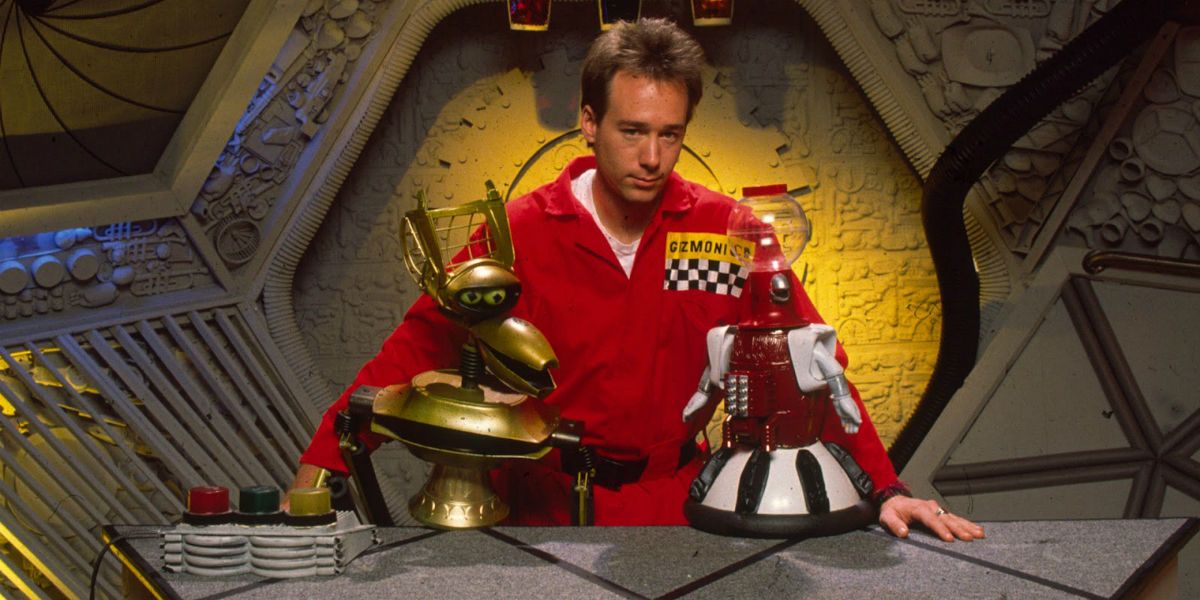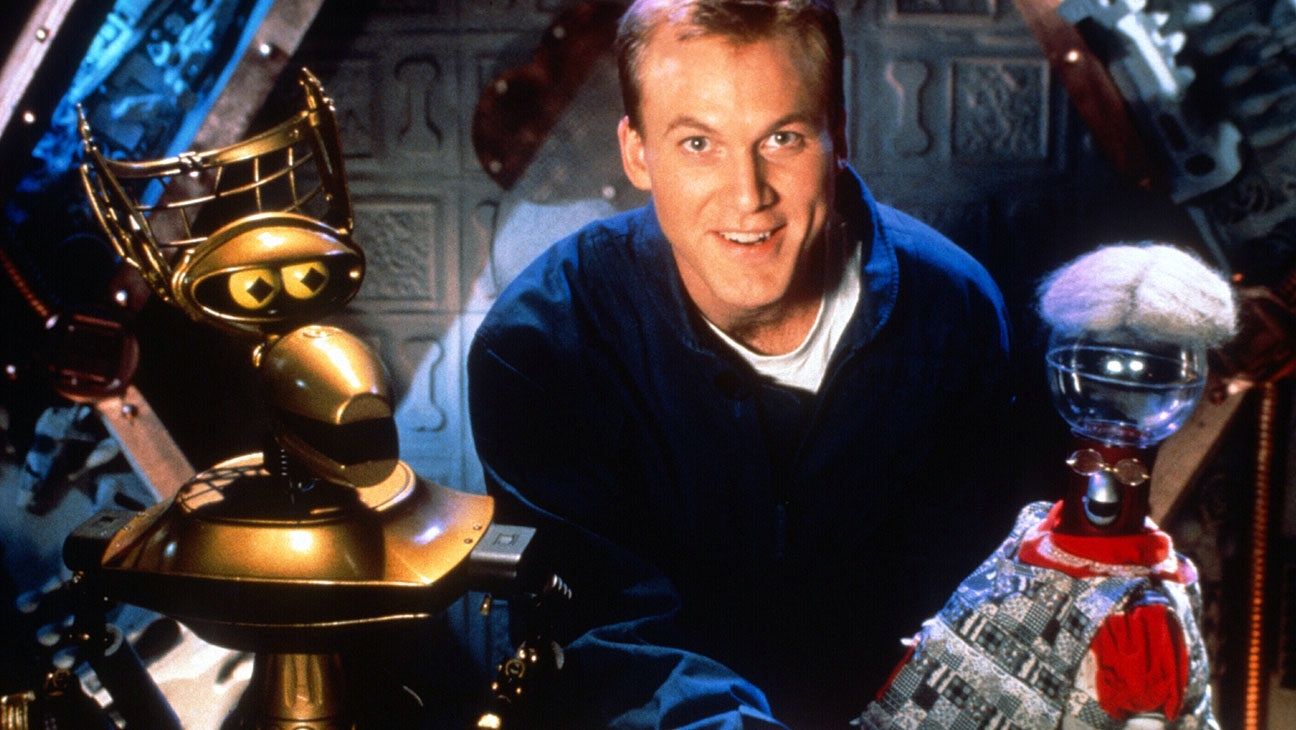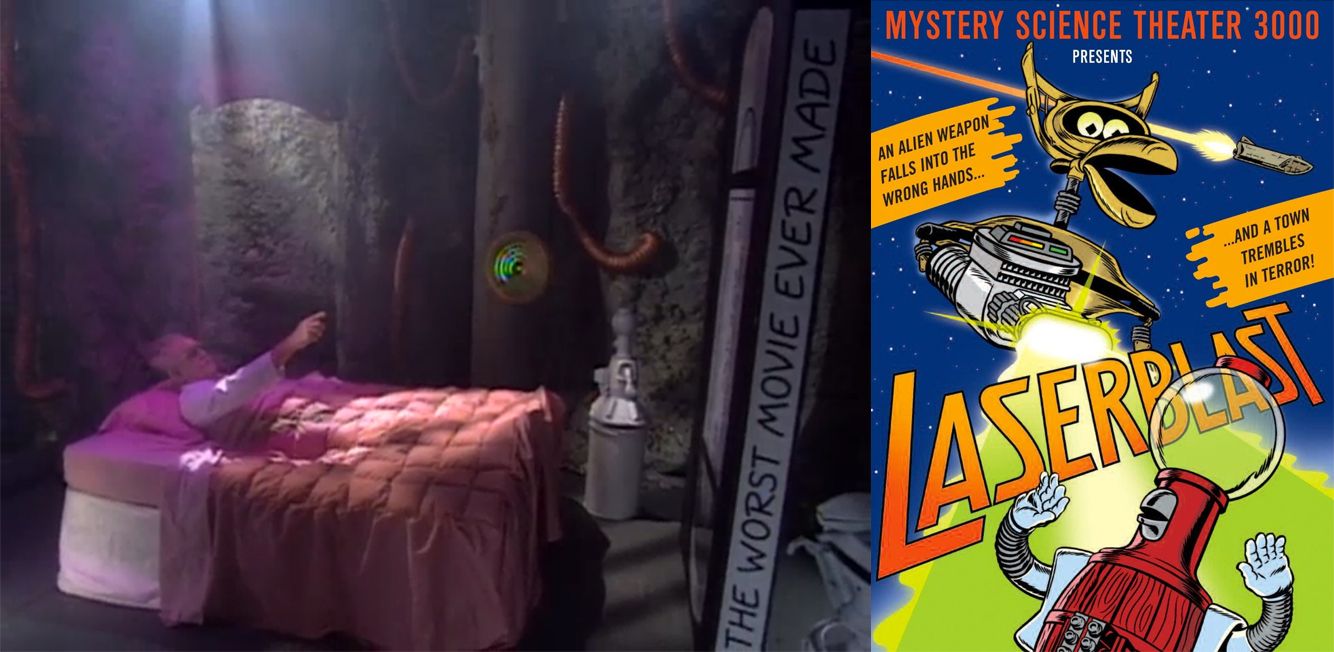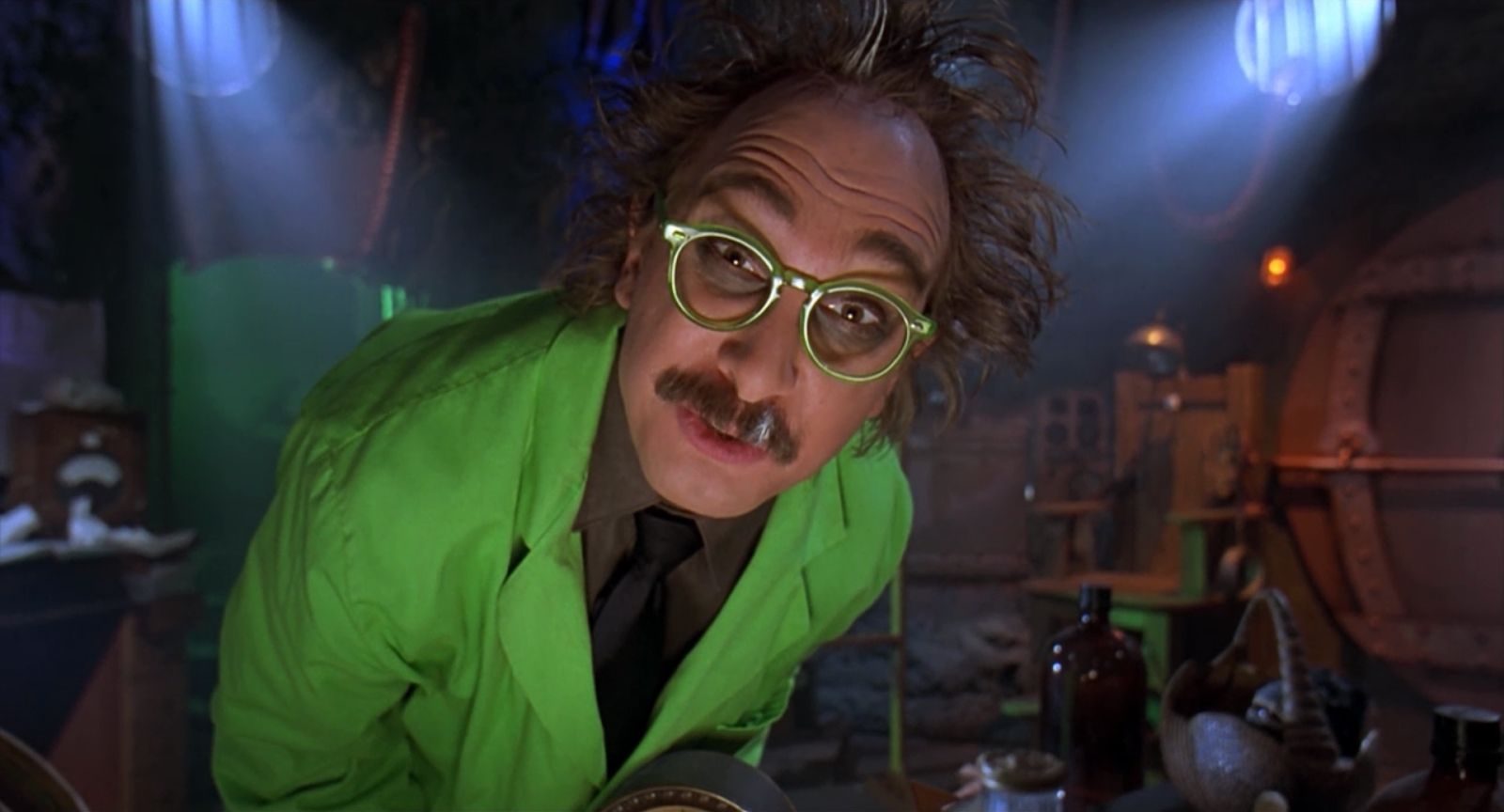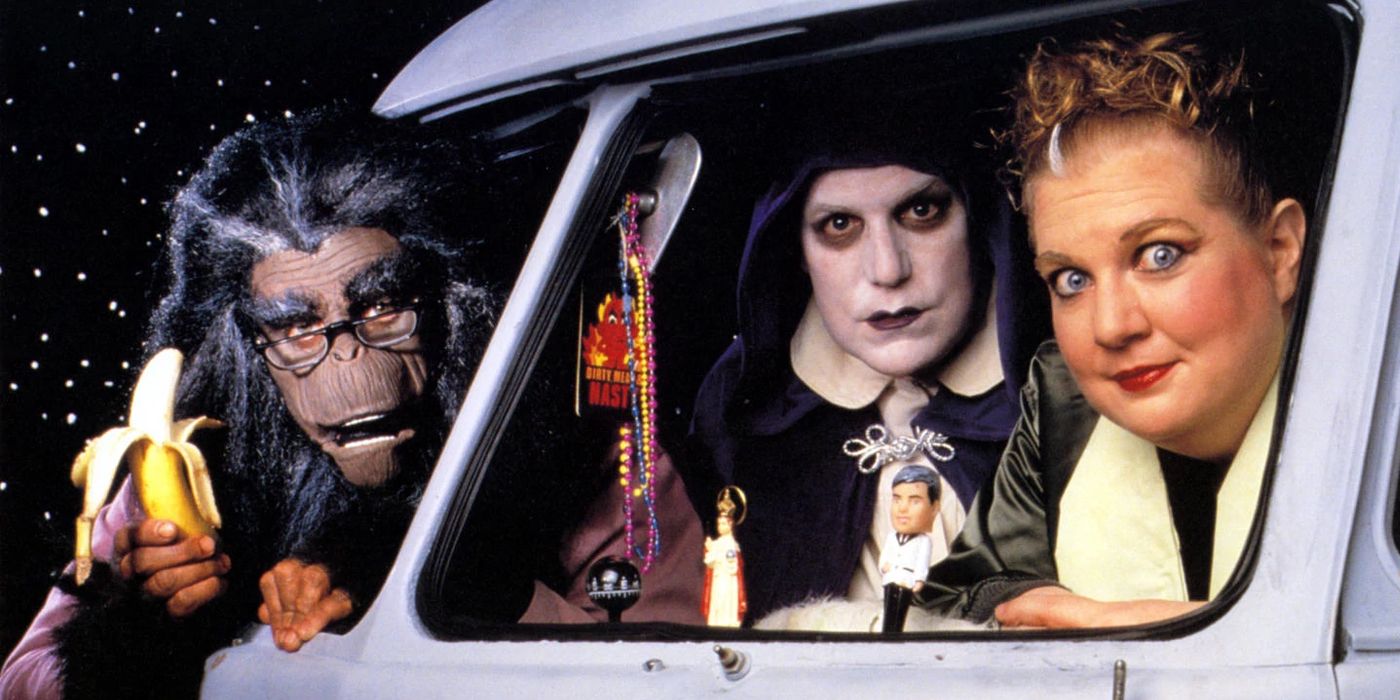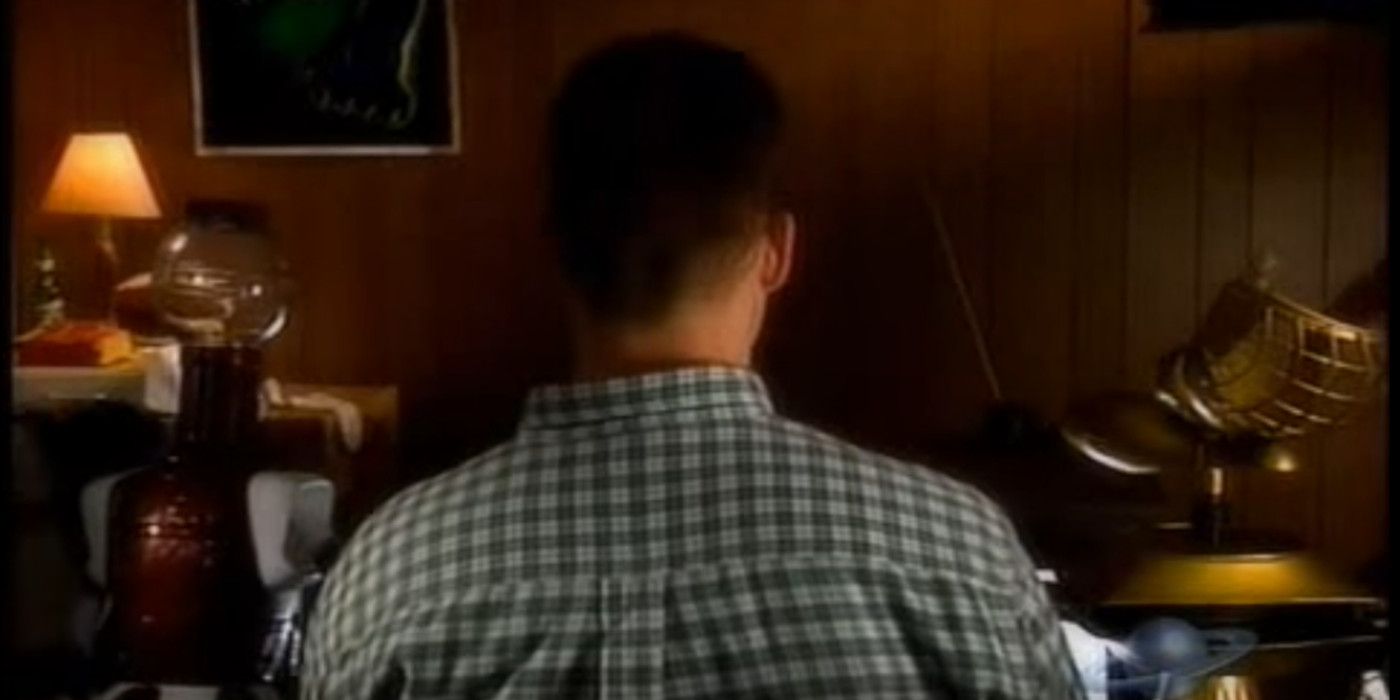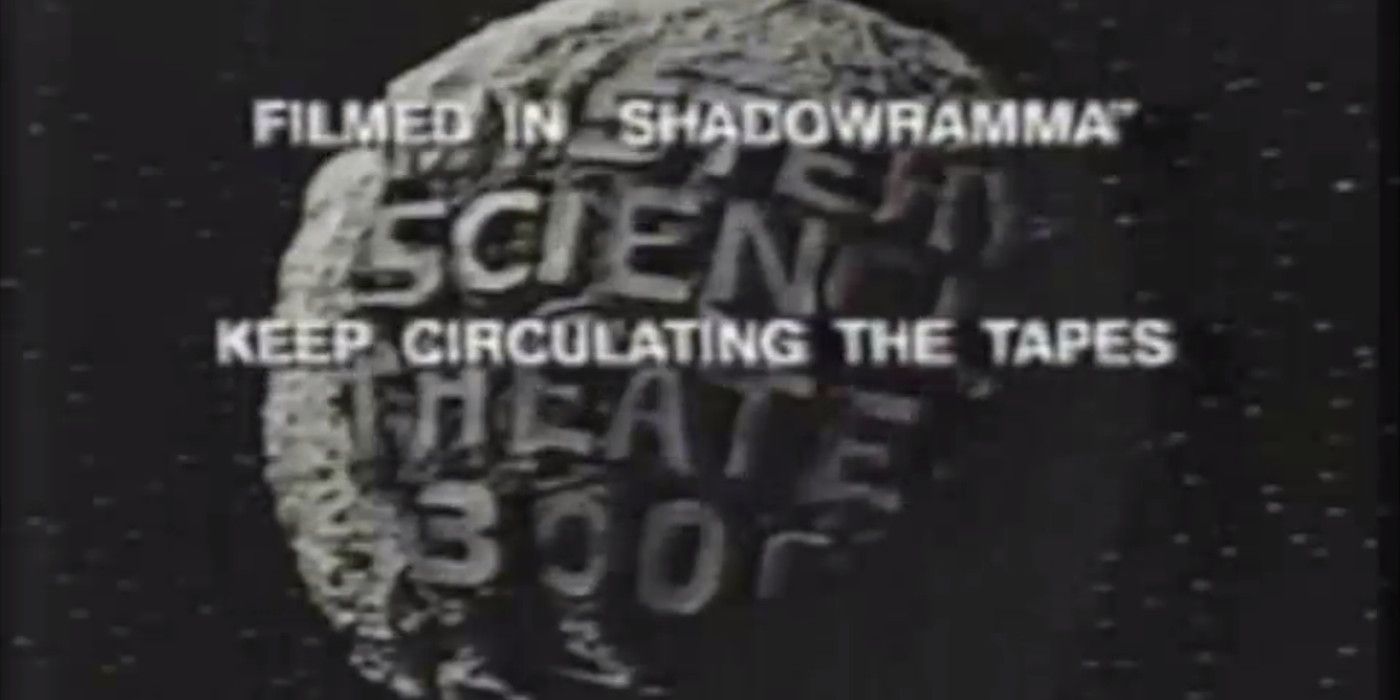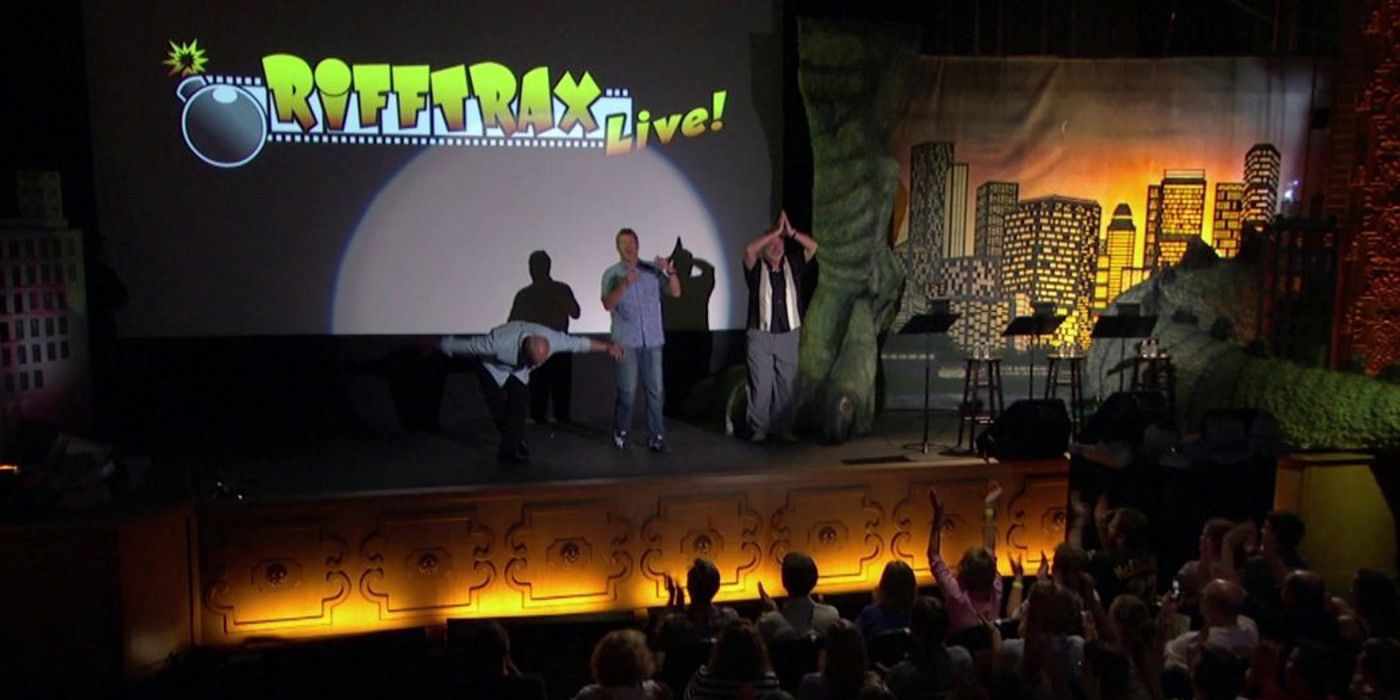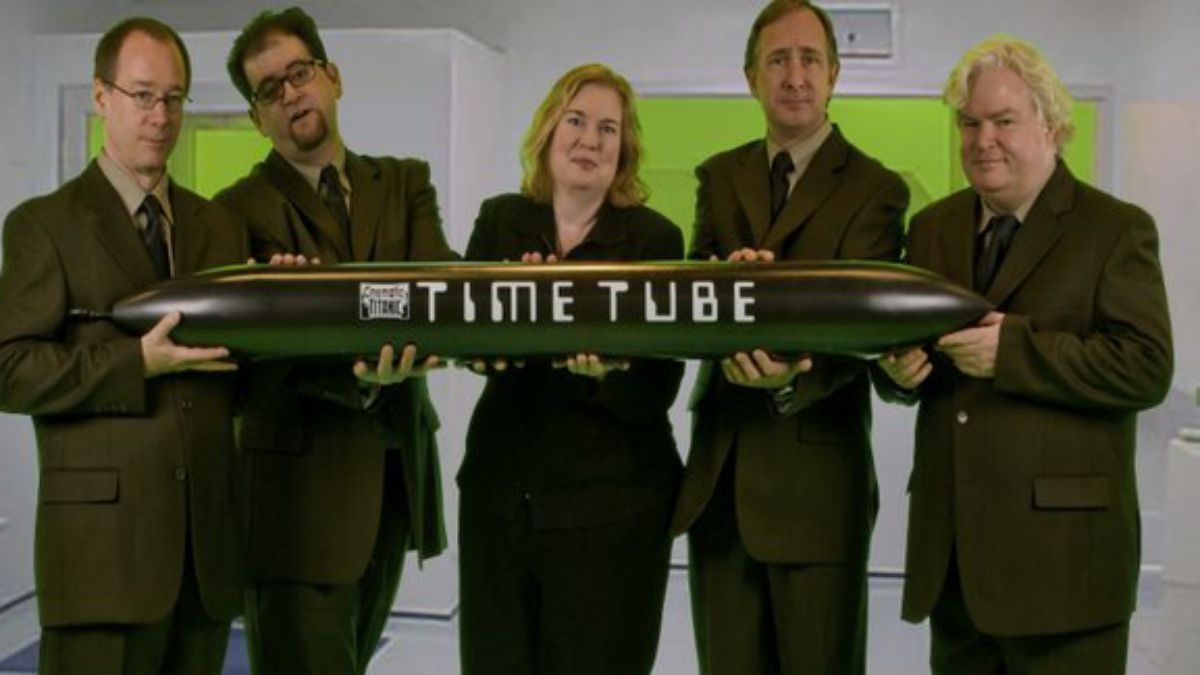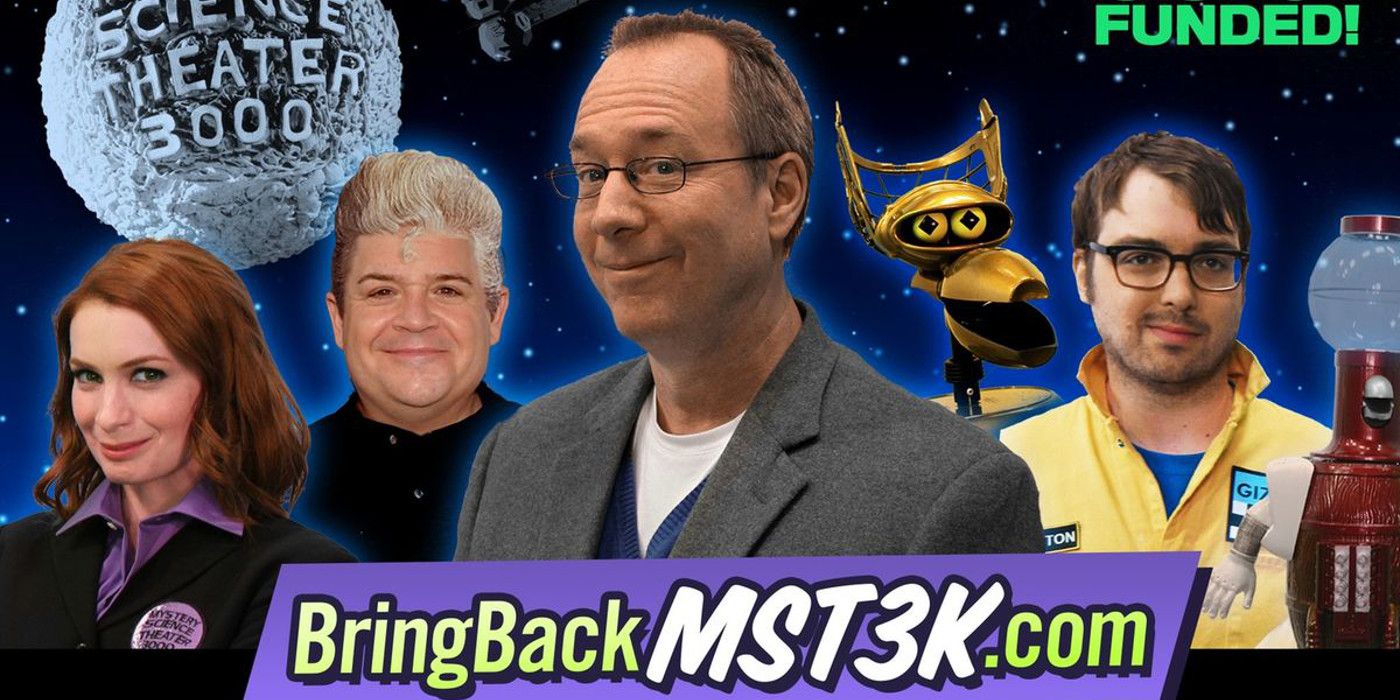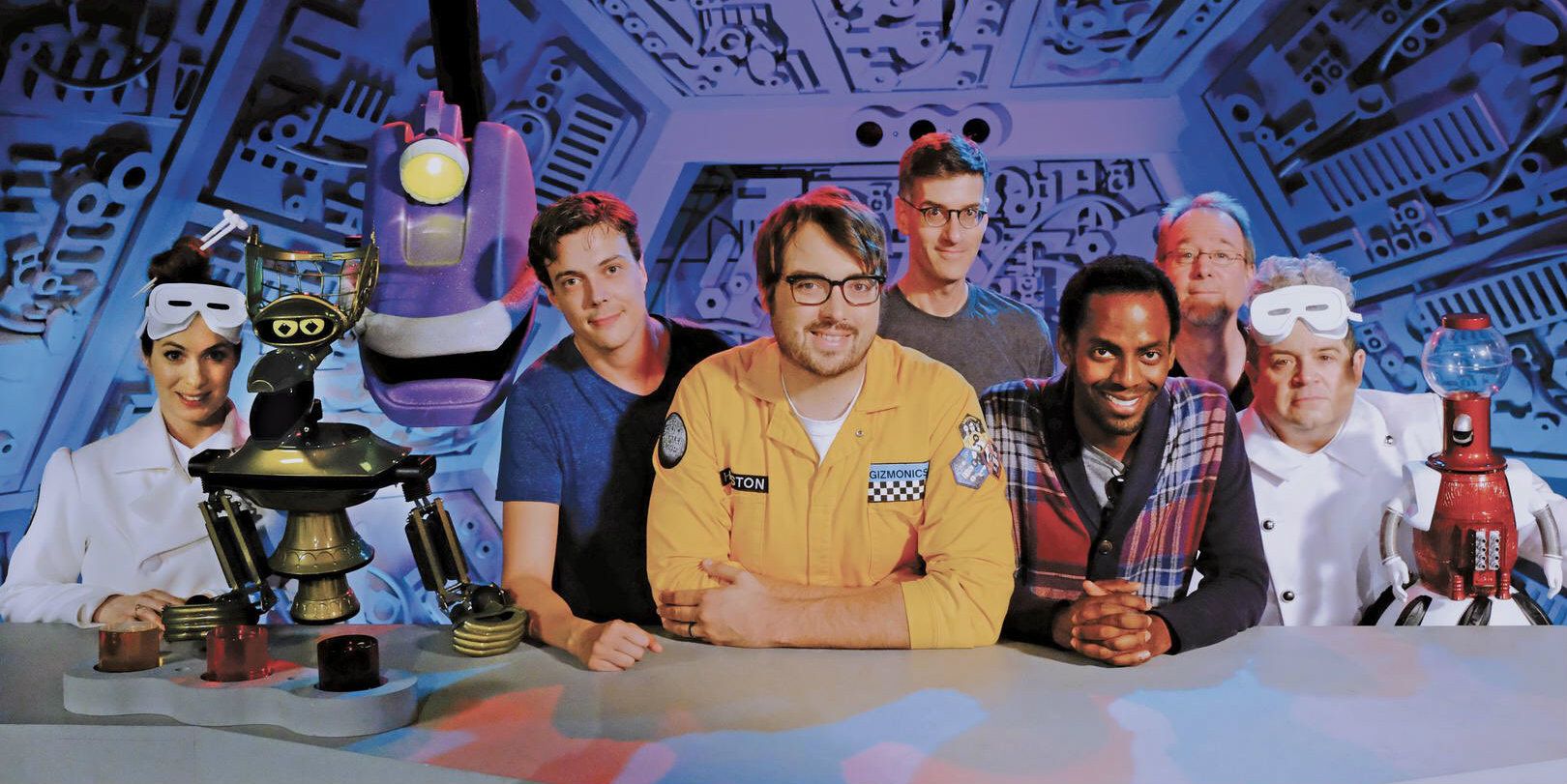This week, one of the most important and influential television comedy series of all time (of the '90s, certainly) made one of the most improbable returns in broadcast history: Mystery Science Theater 3000 has launched its 11th season on Netflix, completing a journey that began on cable access television and has now carried a growing group of eclectic talents to geek-culture royalty and earned a fierce following of loyal fans referred to as MiSTies.
Whethe you're planning to watch the MST3K revival, or are simply seeking answers as to why your friends and colleagues are taking a weekend off to binge-watch a Netflix puppet show, let this handy recap be your guide!
WHAT IS MST3K?
Mystery Science Theater 3000 ("MST3K" from here on out) is a TV series created by prop-comedian Joel Hodgson, originally airing as local cable-access programming in Minnesota and later picked up by Comedy Central, the Syfy Channel and now Netflix.
An extrapolation of the old "Creature Feature" hosted-movie model (think Elvira or Svengoolie), the series features performers (a single human host and two or more puppets) providing humorous commentary over "bad movies" - typically obscure low-budget genre films - plus interstitial comedy sketches starring the same characters. During the movies, the hosts' silhouettes appear on the bottom of the frame as though they're watching in a movie theater. The series is credited with popularizing "movie riffing" as a comedy subgenre.
Canonically, the reason for this scenario originally goes like this. In the "not too distant future" ("Next Sunday A.D.") mad scientist Dr. Clayton Forrester (Trace Beaulieu) is seeking to isolate and weaponized "the worst movie ever made." To this end, he traps laconic janitor Joel Robinson (Hodgson) on the orbital "Satellite of Love," where he (Forrester) uses control of the satellite's air supply to force him to watch bad movies until one is found that can break his spirit. To survive psychologically intact, Joel constructs a pair of robot friends (birdlike Crow T. Robot and sentient gumball machine Tom Servo) to keep him company and help "fight back" against the movies by making jokes about them. Two other robots, the serpentine Gypsy and moving camera Cambot, control the satellite's life-support and video feed, respectively.
That status quo (i.e. mad scientist, captive host, robot pals, bad movies) has remained mostly in place for the duration of the series. The names and faces, however, have undergone many gradual variations - with fans eternally debating which combination was the "best" of the bunch.
IN THE NOT TOO DISTANT PAST
Hodgson created MST3K along with producer Jim Mallon for local broadcast in the Minnesota area for the KTMA cable station in 1988, originally appearing in the persona of a blissfully laid-back long-haired hippie as part of an aesthetic that paid clear homage to the 1972 science fiction classic Silent Running (which stars Bruce Dern as the sole human astronaut aboard a primarily robot-run spaceship containing the last of Earth's still-living plant life). What survives of those early episodes (hard to find collector's items, even in the digital age) shows off a rough, unfinished feel, but what would become the series' reigning sensibility is present from the start: Sets and props that are amusing in their cheapness but impressive in their elaborateness, a sense of humor wedged comfortably in the same family-friendly but not adult-alienating zone of the early Muppet vehicles, and an offbeat affection for pop-culture detritus.
After a single season as a "local sensation" on KTMA, HBO picked up the series from Hodgson and Mallon's newly-incorporated "Best Brains" production outfit as a freshman series for the newly-launched Comedy Channel (later Comedy Central.) Production stayed in Minnesota, hiring mostly local comedy talent like Beaulieu (who also voiced Crow T. Robot) and J. Elvis Weinstein as Forrester's henchman Lawrence Earhardt; along with writers like Mary Jo Pehl, Michael J. Nelson, Frank Conniff (who took over as Forrester's new assistant, "TV's Frank," in Season 2.) Kevin Murphy, who'd been a cameraman at KTMA, replaced Weinstein as the voice of Tom Servo.
The first five seasons in this status quo, referred to by fans collectively as "The Joel Era," is seen by many as the Golden Age of the series overall. Interestingly, however, at this point it's also the most different-feeling in terms of the eventual majority of MST3K episodes and the myriad "riffing" comedy-series (especially in the YouTube era.) Despite the pretense of the bad movies being "torture," Hodgson's easygoing style and unassuming presence - partially the result, Hodgson would later explain, of being ill at ease on camera - gives the proceedings an affectionate tone. It's easy to see the creator's own lovingly hand-made cardboard and hot-glue aesthetic as being a creative cousin to the strange shoestring oddities being riffed, rather than an oppositional force. Perhaps the most famous episode of the Joel Era, Manos: The Hands of Fate, was a no-budget horror opus independently produced by a Texas small businessman in order to win a bet, and went unseen by almost any living person for decades before Hodgson and company unearthed it and transformed it into a new cult-classic.
HOST VS HOST
In terms of 1990s basic cable programming, Hodgson's creation was a monster hit: Unquestionably Comedy Central's signature original series in the era prior to South Park and The Daily Show. A darling of critics and offbeat comedy fans, nominated for TV awards, winner of a Peabody, syndicated in bite-sized hour-long format as "The Mystery Science Theatre Hour" and possessed of a grassroots fanbase-explosion that would have likely produced an avalanche of merchandise in today's fandom economy. And while producer Mallon was aggressively maneuvering to expand the show's imprint to conventions, a better deal with Comedy Central and even a feature-film adaptation, the attention and pressure of a regular series were seemingly disagreeing with Hodgson's constitution. To the shock of many fans, Joel departed the series midway through Season 5 during the riff of the Joe Don Baker cop movie Mitchell (with "Joel Robinson" finally managing to escape the Satellite of Love, albeit unintentionally and with an assist from Gypsy), with longtime head-writer Michael J. Nelson stepping in as the series' new regular host "Mike Nelson."
While the core setup of the series remained the same (and there are plenty of fans for whom the longer-serving Nelson is the preferred MST3K frontman), the "Mike Era" established itself as an ever-so-slightly different creature fairly early on. A quick-witted snarker with a classically "TV handsome" profile, obvious comfort as an on-camera personality and particular gift for obscure celebrity impression, Mike brought a markedly different energy to the proceedings than had Joel's laid-back straightman. "Invention Exchanges" (effectively a showcase for Hodgson's prop-comedy roots) were phased out as a regular pre-movie host segment, and the overall comic tone trended more in the direction of banter-driven pop-culture reference. The biggest change, though, was in the relationship of the main characters. Whereas Joel behaved more as an affectionate but occasionally-exasperated sitcom father figure to Tom and Crow, Mike and The 'Bots operated on a more equal footing: A trio of "best bros" somewhere between The Three Stooges and a drivetime talk-radio team.
That new tenor carried over into the movie-watching segments, but the overall sensibility of the commentary remained fairly consistent with what fans had come to expect from the series - unsurprising, considering that Mike had been the head writer for most of the Joel Era as well. Core MiSTies remain strongly divided on every change the show has undergone (not only Mike vs. Joel, but also a radical shift in lighting-design from the brightly-lit Joel Era to a darker "mood light" aesthetic adopted midway through Mike's tenure), but it's a testament to the series as both a strong concept and an ensemble production that MST3K not only survived, but thrived following the departure of its original creator - at least for a while.
A CHANGING WORLD
MST3K was the "crown jewel" original program that helped Comedy Central weather the lean early years when its lineup consisted of little otherwise than low-budget sketch series, stand-up comedy reruns from the HBO library and re-runs of obscure sitcoms like the failed pre-fame Jim Carrey vehicle The Duck Factory. But as the channel rose to cable prominence, the "bread and butter" of cable comedy had shifted from the weird and offbeat to "edgier" answers to topical, ripped-from-the-headlines network fare - and a 2 hour (with commercial breaks) puppet show about cheesy movies, staged in such a way that channel-surfers might think it was "only" a cheesy movie and skip right by, was essentially the polar opposite of what advertisers wanted.
The 6th season drew lackluster ratings, thanks in no small part to a shifting time slot and claims (from Best Brains) of unfriendly leadership from new Comedy Central programming head Doug Herzog, who was the driving force behind a push for the network to move away from "niche" productions like MST3K overall. Herzog would ultimately cancel the series, though fans were at least able to enjoy an abbreviated final season wherein Doctor Forrester was joined by his equally-evil mother Pearl (Mary Jo Pehl) after the departure of Frank Conniff, with TV's Frank ascending to "Second Banana Heaven." The blowback from MiSTie fans against Comedy Central and Herzog in particular were the stuff of TV industry legend for years after, though at least on the business side his pivot to "edgy" content would eventually come to be seen as major success story with the acquisitions of Politically Incorrect, The Daily Show and South Park.
The series even aired a proper finale, wherein the Satellite of Love drifted to the edge of the universe and Mike, Tom, Crow, Gypsy and Cambot transformed into noncorporeal energy beings - finally escaping the ship as Doctor Forrester undergoes a 2001-inspired cosmic-rebirth (complete with a giant VHS copy of the still-undiscovered Worst Movie Ever Made standing in for The Monolith) into a Starchild - all designed to give fans a sense of closure should efforts to get the series picked up on another network not come to fruition. However, it wasn't the only "last chance" said fans would have at seeing the concept play out in its then-present form...
MST3K: THE MOVIE
Directed and produced by Mallon (whose aggressive push to turn the series into a theatrical franchise was later said to be among the main points of creative disagreement that had led to Hodgson's departure in Season 5) in 1996, concurrent with the 6th and 7th seasons of the series, Mystery Science Theatre 3000: The Movie was a troubled production that (despite strong reviews and an overwhelmingly positive response from fans) served as something of a harbinger of the series' end on Comedy Central, where it struggled to "fit in" with increasingly edgy programming demanded by the network.
Shot on more expensive but still deliberately cheap-looking sets, and making no reference to the earlier continuity of the series re: Joel or TV's Frank, the film otherwise takes the form of a standard episode - albeit one focused on a slightly higher caliber of "bad movie" in the form of the Universal Studios sci-fi mini-epic This Island Earth. The film was originally set up to be made at Paramount Pictures, but fell apart when the studio insisted that a movie version should drastically reduce or remove entirely the movie-watching segments in favor of a plot-driven "origin story" for Mike and The 'Bots. Universal picked up production instead, but ultimately dumped the film on the Grammercy Pictures subdivision for a largely unpromoted run in only 26 theaters in the U.S., leading to a box office disappointment.
THE SCI-FI CHANNEL ERA
MiSTies are nothing if not loyal, and a massive grassroots campaign to get the series picked up on another network eventually gained the attention of the newly-launched Sci-Fi Channel (today called "Syfy") which, like Comedy Central back in the day, was looking for original programming to help it transition away from being a primarily re-run driven operation. Outwardly, Sci-Fi rolled out the red carpet for a new MST3K, granting it a giant presence on its original website and running specials to catch new viewers up to speed with the legacy of the franchise - though were not, however, able to air the original episodes (see below). However, behind the scenes the road to a new season was slightly bumpier.
For starters, Trace Beaulieu declined to return for an 8th season. Not only did that mean finding a new voice for Crow T. Robot (comedian Bill Corbett eventually won the role), it meant that the series would have to make do without Doctor Clayton Forrester (the last remaining link to the founding season), and the decision to elevate Mary Jo Pehl's Pearl Forrester to the status of new main villain was immediately controversial among fans, many of whom had not warmed up to the character during her tenure in the abbreviated Season 7. Additionally, the Sci-Fi Channel initially pushed the creators to shake-up the formula of the host segments, asking that the series establish an episodic continuity to encourage regular viewership and allow for new characters to appear - and most notably of all, the network mandated that they only riff on movies from the science fiction genre.
As such, the 8th Season is easily the most unusual in terms of presentation. The basic format of riffs and interstitials remained unchanged save for the new single-genre focus, but outside The Theater the characters were now engaged in a series of comedic adventures. Drawn back to the Satellite (and their physical bodies) by unknown forces, Mike and The 'Bots find themselves now centuries into the future, at first confronting an Earth turned into a Planet of The Apes parody and later visiting (and accidentally destroying) other worlds and even taking a time-travel trip to Ancient Rome - pursued all the while by a similarly time-displaced Pearl Forrester, who aims to continue her son's bad movie experiments aided by her henchmen Dr. Bobo (an ape scientist played by Kevin Murphy) and Brain Guy (aka "The Observer," a parody of Star Trek-style "advanced being" aliens, played by Corbett, who carries his own brain in a glass dish).
THE END (AGAIN)
Odd-season-out or not, Season 8 was a solid initial success for Sci-Fi and MiSTie fans received it with overwhelming positivity, eventually embracing Pehl's more fleshed-out characterization of Pearl and anointing Bobo and Brain Guy as new fan-favorites. Sci-Fi would relax its upper-level interference for Season 9, loosening the "sci-fi-only" mandate for movie subjects and allowing the host segments to settle into a more traditional framing with the villains now operating out of "Castle Forrester" rather than continuing the "space chase" storyline. But the showrunners would still never again have the kind of freedom the series had enjoyed in the early Comedy Central days - it was eventually clear that things had seemingly run their course.
MST3K would air for two more seasons on the network (with Frank and Joel even making in-character cameo returns to celebrate the first episode of Season 10), with several episodes from this Sci-Fi channel run now recalled as some of the series' very best both by longtime MiSTies and new fans who discovered it in its second run. But the quirky series eventually ran into many of the same problems that had scuttled its original run (changing network leadership, the amount of airtime it took up versus the scale of its ratings compared to other fare) and this time there was significantly less of an active attempt by the creators to boost fan campaigns for another relaunch.
Faced with what seemed to be the end for real this time, MST3K ended its run on August 8th, 1999 with Diabolik. In the episode-proper, The Satellite of Love crashes back to Earth as Pearl Forrester calls it quits on the experiment. Mike and The 'Bots ultimately survive, with the final scenes showing him, Tom and Crow (Gypsy having become a successful entrepreneur) sharing a small suburban apartment and settling in to watch a movie - which happens to be The Crawling Eye, the first film riffed in the first Comedy Central season.
KEEP CIRCULATING THE TAPES
You may find yourself wondering how a show that aired 211 episodes over an 11 year period can still be considered something of a niche cult item. Star Trek, after all, only needed three seasons worth of constantly-syndicated material to accrue the pop-fandom by which all others must be judged. But new fans can't "discover" a series if they can't find it, and for a long time the bulk of Mystery Science Theater 3000 was all-but unviewable either in reruns or on home video. The series was always going to be a hard fit for syndication owing to its plus-sized length, hence why Comedy Central chopped up a selection of popular episodes into the MST3K Hour format and managed to syndicate them to limited success. But the biggest hurdle was the fact of how the series was produced.
As you might imagine, licensing movies for rebroadcast can be expensive - even for old and not very well-known films. Plus, not every rights-holder is going to be amenable to rebroadcasting/selling a reworked version of their product. MST3K got around this limitation, in its broadcast cable form, by largely utilizing films that had already been licensed by the networks the series itself was airing on - effectively designating MST3K episodes as use of those films under the original license and therefore not having to pay any extra fees. However, this also meant that they did not generally have the rights to sell copies of the episodes themselves or rebroadcast otherwise without negotiating new contracts... and, ironically, the act appearing on MST3K wound up turning several subjects into much more high-profile (and thus expensive) items for their rights holders. As such, over the years the series built much of its broader reputation on the fan-convention "tape swapping" circuit, leading Best Brains to make "Keep Circulating The Tapes!" a sign-off model for the series itself for many years.
Eventually, a solid selection of episodes was licensed for home video by Rhino. More recently, the retro-specialists at Shout! Factory (who are also involved in the reboot) had managed to get an unprecedented number of episodes onto DVD and streaming, but many fan-favorite episodes remain unavailable save for sketchy "fan uploads" to YouTube and other video sites. A DVD release from several years ago that included one of the Godzilla-centered episodes was pulled quickly from market after a cease-and-desist from the notoriously litigious Toho Studios, and is now a sought-after collector's item. Bottom line: Those looking to "dive into" MST3K's back catalog as new fans have always encountered a fair amount of resistance.
Another more curious development, however, is that many folks have subsequently become fans of the series stars and their movie-riffing exploits... without having heard of MST3K itself...
UNEXPECTED AFTERLIFE
Few of MST3K's principal players were especially well-known when the series launched, and when it concluded most went back to regular careers in comedy-writing and other fields. But as fandom for the series experienced a new wave of growth with the advent of the internet - both in the form of a whole new way to "circulate the tapes" and the series' often-stated influence on a new generation of web comedy stars like The Nostalgia Critic, The Angry Video Game Nerd and others - the once and former Mads and Bots began to find renewed success with new slants on the genre they'd helped invent.
Michael J. Nelson, Kevin Murphy and Bill Corbett made an early minor breakthrough with a project called The Film Crew, wherein they introduced public-domain short subjects on DVD, performed intros for various films on AMC, and participated in a series of made-for-DVD productions wherein they riffed on old movies MST3K-style (minus the sillhouettes) at the behest of a corporate benefactor. While initially well-received, the series (being produced for Rhino Home Video) was stalled when it was accused of being too legally similar to MST3K itself by Jim Mallon, who had become the sole rights-holder of Best Brains and all associated material in the interim (Shout! Factory would eventually settle the rights to sell/broadcast the Film Crew episodes). The trio instead retooled the concept into the Rifftrax downloadable-commentary operation, which has become a massive success and led to Nelson, Corbett and Murphy performing a series of globally-broadcast Rifftrax Live events both for budget titles like Samurai Cop and big-budget features like Starship Troopers.
Though seen by many as the direct spiritual successor to MST3K, it's notable that Rifftrax is mainly comprised of the series' Sci-Fi Channel-era riffing trio. Some of the series other veterans, meanwhile, reunited for a project of their own under the auspices of a returning Joel Hodgson. Dubbed "Cinematic Titanic," this post-MST3K production took the form of mainly live performances featuring Hodgson, Mary Jo Pehl, Trace Beaulieu, Frank Conniff and J. Elvis Weinstein that were later released to DVD. These were more similar to MST3K in spirit than Rifftrax, focusing on older B-movies and utilizing a more elaborate form of the shadowplay conceit along with a backstory that referenced the performers experience on the previous series as a primer for this new venture. Though not as prominent as Rifftrax, Cinematic Titanic toured for six years between 2007 and 2013.
In 2016, Rifftrax held a special reunion event wherein Nelson, Corbett and Murphy reunited onstage in Minnesota with Hodgson, Pehl, Beaulieu, Conniff, Bridgett Nelson (Michael J. Nelson's wife and a supporting-character performer on the series) for the first time since the end of MST3K-proper, along with MST3K reboot host Jonah Ray. Various combinations of the team riffed a selection of short subjects, while participating in a Q&A and promoting their own projects including upcoming Rifftrax shows and the reboot - which by then had become the most successful film/video Kickstarter ever.
KICKSTARTING THE FUTURE
Since 2010, Joel Hodgson had been in active negotiations to reacquire the rights to the MST3K brand for a hoped-for revival, having identified Netflix and other streaming services as a place where a renewed vision of his original concept could flourish. Working closely with Shout! Factory, Hodgson eventually gained control of the brand back from Jim Mallon and Best Brains around 2015 and began what would ultimately become the biggest Kickstarter film success story ever.
While some balked at the initial goals set for the production ($2 million to guarantee at least three new episodes, with stretch goals for a possible 12 more), fan desire to see more MST3K proved reliably ravenous: The project ultimately blew past the previous record held by the Veronica Mars movie to the tune of $5,764,229, with an additional $600,000 in backer add-ons. As the campaign rolled out, Hodgson kept fans excited with gradual reveals of the new-generation cast who'd be inheriting the onscreen riffing duties; including the aforementioned Jonah Ray as new host "Jonah Heston," Hampton Yount and Baron Vaughn as the new Crow and Tom and nerd-comedy icons Felicia Day and Patton Oswalt as Dr. Forrester's daughter Kinga and TV's Son of TV's Frank - with Pehl, Corbett and Murphy set for cameos as Pearl, Observer and Bobo plus "open invites" for other cameos as well.
That brings us up to the present, with the new series of MST3K having launched in its entirety on Netflix at Midnight PST on April 14th.
THE MORE THINGS CHANGE
At this point, it's all over but for the riffing (and, perhaps, the answering of yet-undisclosed secrets like how/why Tom, Crow and Gypsy are "back" in The Experiments in the first place...) It'll take a few days for even the most devout MiSTies to watch all 14 new episodes, and likely longer for the nostalgia wave to settle as fans and casual viewers alike assess the full breadth of what's before them: Does it hold up? Is it as good or better than previous iterations? Is there still really a place, beyond the aforementioned nostalgia, for MST3K in an era where every obnoxious high schooler with a webcam is recording their reactions to every other scrap of pop-flotsam that floats across the web? If the series is a success, will there be more new seasons to come - and could it finally spur Shout! Factory to undertake the goal bringing something like the entire catalog to official release?
For now, one thing is for certain: Mystery Science Theater 3000 lives again, and thus far the early reactions are calling it a successful return. Most fans never would've truly thought that possible even for a one-off special, and now they have an entire new season to experience. In an uncertain time, that's something worth taking real stock of; whether you've been waiting for this since 1999 or just came across it on your Netflix Reccomendations for the first time.
We've got movie sign.

